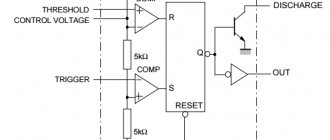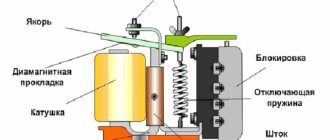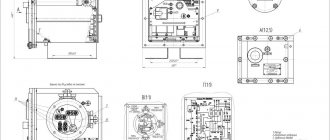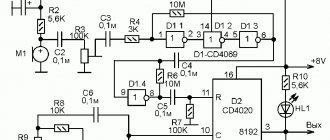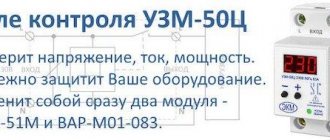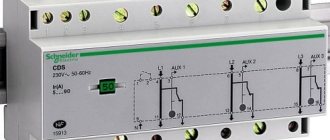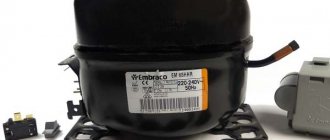Types of time relays
Time relays are differentiated according to the following types:
- Electronic. The most common type. They have a wide range of time intervals (from hundredths of a second to several thousand hours). They are easily programmed in accordance with the needs of the technology, have small dimensions and low power consumption.
- With slowdown. There are pneumatic and electromagnetic. The first ones have a pneumatic damper, also called a cataract, which provides a dwell time of 0.4-180 seconds. It is regulated by changing the diameter of the inlet for air access. Switching accuracy is up to 10%. The second (electromagnetic) are used only when working with direct current. They are equipped with an additional short-circuited winding, in which a magnetic flux opposite to the main one is created, which slows down the relay response time. This, when turned on, gives a delay of 0.07-0.11 seconds, and when turned off, 0.5-7 seconds.
- With clock mechanism. An anchor mechanism consisting of a gear with back-sloping teeth and an anchor-like anchor that receives impulses from the gear teeth with curved blades. The spring that drives this mechanism is located under the electromagnet. The contacts close after the end of the period set on the scale. Time interval 0.1-20 seconds, accuracy up to 10%.
- Motor. They consist of a synchronous electric motor, an electromagnet, a gearbox and contacts. The electromagnet engages the motor with the gearbox and the countdown begins. Delay period from 10 sec. up to several hours.
Structurally, the relay is manufactured for installation on a regular surface, on a Din rail, on the surface of a power panel (front panel with indication and control elements). The wires can be connected: rear, front, through a block or connector. To set the time interval, various switches, variable resistors or buttons (in electronic relay models) are used.
Material on the topic: What is a capacitor
In most cases, time relays are miniature electromagnetic relays powered by voltages ranging from 5 to 48 volts. Moreover, their switching current ranges from 3 to 16 amperes. Typically, time relays provide galvanic isolation between the relay power supply circuit and contact groups.
Time relay modules
The impulse to start timing in a time relay is:
- power supply to the relay;
- relay power failure;
- control signal;
- reaching the specified time (in programmable relays).
It will be interesting➡ What is an intermediate relay?
Modern electronic relays use:
- transformerless power supply (capacitor circuit);
- switching power supplies;
- regular transformer power supply (rare).
The timer uses the following as an actuator:
- electromagnetic relay;
- transistor (at a constant current of 12 or 24 volts);
- optocoupler
For use in microprocessor technology (if it is necessary to provide galvanic isolation of circuits or increase speed, and also where it is desirable to replace standard contacts with electronic switching due to repeated operation);
- optosimistor (for controlling starters and contactors);
- optotransistor (for regulating solid-state relays).
Simple time relay circuit
In addition to the indicated areas of application, a time relay is used for automatic adjustment of actuators using arbitrary sequences of signals in a variety of technological equipment. Thus, the relay is used as a programmable machine for regulating the synthesis of substances, drying, galvanic and other complex technological processes, after working out a predetermined time interval, according to the established operating mode, with an indication of a decrease in the set time. Timers are also used to switch the windings of an asynchronous electric motor from “star” to “delta” when starting the electric motor.
Relay types
Functions
By function, time relays can be divided into:
- multifunctional (for example, 10 temporary functions)
- single-functional (delayed switching on, switching on at a designated time, cyclic operation process).
power unit
The second, no less important division is the power supply. Can be divided into two types:
- designed for a specific voltage 24 V, 110 V, 230 V
- universal, e.g. 12 to 240 V AC/DC.
Number of contacts
The most common solutions are with one, two, three or four changeover contacts. Depending on the manufacturer and model, individual solutions may vary.
Frame
Programmable relays are most often found in a modular housing that allows them to be mounted on a TS-35 rail, also known as a DIN rail. Similar (functionally) solutions from different manufacturers may differ in dimensions (number of module spaces in the switchgear). For time relays in housings other than modular, check for additional accessories, such as a mounting socket.
Design and types of time relays
A time relay consists of a sensing, retarding and actuating parts, each of which has a specific function. The sensing part starts the device after a control signal is received on it, the slowing part is responsible for the set delay interval, and the executive part, after a given time interval, affects the controlled device.
Material on the topic: the device of a trimming resistor.
The PB design consists of a wire coil wrapped around a metal core. In addition, the device includes a set of contacts, a movable pointer and an iron anchor. Different types of relays use different numbers of moving contacts. Time relays are classified according to various criteria. So, in terms of execution, the RV can be:
- monoblock. In this case, the device is completely independent, has built-in power supply and inputs for connecting devices;
- built-in This species does not have a body or its own food. Such a relay is used for the manufacture of complex devices;
- modular. This device is similar to a monoblock and is most often used for installation on a DIN rail in electrical panels.
RTs also differ in the method used to create the time interval:
- sentry or anchor - the very first radios, which are considered one of the most reliable and are widely used to this day;
- motor - these devices include electrical contacts, a gearbox and a motor. They help carry out scheduled work on equipment on time;
- relay with pneumatic and hydraulic retardation - interval regulation in these devices is carried out by reducing/increasing the supply of liquid or air to the working volume;
- electromagnetic - used only in circuits with direct current;
- electronic - the most common type of relay, which can provide an interval from a fraction of a second to several months, and sometimes years. Thanks to quartz frequency stabilization and time synchronization to a reference clock via radio or the Internet, these devices are extremely accurate.
It will be interesting➡ A few facts about RKN (Voltage Control Relay)
Separately, it is worth noting that electronic radios, due to the presence of inputs and outputs for feedback, as well as advanced programming that sets the desired operating algorithm, belong to microcontrollers. Time relays with electronic delay are small in size, low power consumption and high autonomy.
Diagram of resistors in a time relay
Kinds
According to their design, time relays are divided into:
The monoblock is a completely independent device, with its own housing, built-in power supply and special sockets for connecting any equipment. Those involved in photo printing are well familiar with this type of relay.
Built-in relays are a simplified version of monoblock relays. They do not have their own housing and power supply, since they are needed in order to create more complex devices. They are used as additional elements and therefore they are placed in the same housing with other elements of the manufactured device. A classic example is a timer in a washing machine, microwave, oven, etc.
Modular (with control contact) - this type has standard dimensions and is installed on a DIN rail in the distribution panel.
In addition, time relays are also classified depending on the operating principle (how exactly the time interval is created):
- Time relay with clock mechanism. This type was the first to be manufactured and is still considered one of the most reliable, since its properties are not inferior to pneumatic devices. Their operation is practically independent of voltage power, how often it is applied, or temperature changes. In everyday life, this type of relay is found in mechanical alarm clocks, kitchen timers, and in some washing machines a mechanical program relay is also found.
- With electromagnetic retardation. Used in circuits oriented to constant voltage. The delay is carried out by creating an auxiliary magnetic flux, regulated by changing the tension value of the return spring. The adjustable value is up to five seconds. A significant disadvantage of this type of relay is that the time delay depends on temperature changes.
Electric relay
- Vacuum (electromechanical). This type is used where an electrical or pneumatic signal is required to control whether the vacuum level has been reached.
- Motor. Includes motor with gearbox and electrical contact. The time delay capability ranges from 10 seconds to tens of hours.
- Relay with hydraulic or pneumatic retardation. Time intervals here are regulated by increasing or decreasing the supply of liquid and air into the working process. One of the advantages is that the slowdown does not depend on the voltage, supply frequency and temperature changes. Also, adjusting the delay is not difficult.
- Electronic relay. The most widely used type of time relay, gradually replacing mechanical analogues. The advantages of this type are its small size, weight, high accuracy, reliability and wide selection of operating programs.
Electronic relays are divided among themselves based on the timing technology:
- Digital—voltage is applied to the power supply, which causes the master oscillator to start, which then sends pulses to the counter. The latter, in turn, calculates these pulses until they are equal to the required number of pulses that is specified in the system. Then, a signal is sent to the output amplifier controlling the relay and the counter stops counting pulses. As soon as the voltage is removed from the power supply, the relay will return to its original state. Such radios are capable of delaying time for tens of hours with minimal error. The main disadvantage is the high cost.
- Analog - to delay time, a capacitor is used, to which voltage is applied when the contacts are closed. This voltage is monitored by a special device that compares it with the previously specified one. If they match, the device sends a signal so that the relay switches. The maximum shutter speed here is 10 seconds. This type is superior to digital in that it does not require precise programming and is easier to use.
Design
The design of the time relay is distinguished by a delay mechanism. And the most modern in this regard can be called electronic time relays, which also have another name - electronic timers. They have unsurpassed accuracy and a wide range of shutter speeds - from fractions of a second to several years. Moreover, many electronic timers have the possibility of advanced programming, are equipped with a feedback mechanism and can inform about the presence of a failure when executing a command. And all because electronic timers operate on the basis of digital solutions and are not just logical devices, but full-fledged microcontrollers.
But we should not forget about other deceleration mechanisms, in particular, anchor and clock mechanisms. Here, time is counted using a spring that contracts under the action of an electromagnet. The running speed depends on the current supplied to the winding. Such mechanisms are often used in powerful time relays, designed for a current of several thousand amperes. Due to their design, they additionally serve as thermal protection against overloads.
Next we can note the motor time relays. They count intervals using an electric motor with a gearbox and contacts. It is also necessary to note the deceleration based on hydraulic and pneumatic mechanisms. They regulate intervals by supplying air or liquid to the working area. Finally, it is worth mentioning the mechanism with electromagnetic retardation. It is used only on DC networks and provides a time delay using an additional short-circuited coil. In addition, the design of time relays can be classified by design.
So, it can be modular - convenient for installation on a DIN rail or simply in an electrical panel. The design can be built-in, without its own housing and power supply, which is convenient for creating more complex systems. And there is also a monoblock design, when the time relay is a completely autonomous device with its own power supply and outputs for connecting the load. The scope of application of a time relay is directly dependent on its characteristics and operating principle. Thus, an electromagnetic relay is used to start powerful engines. Other types of RF can be used to control ventilation, irrigation, lighting and heating of premises.
Cyclic time relay
Time relay - features of choice.
In this article we will try to provide a brief overview of simple one-command time relays offered to our potential buyers, to provide a more correct approach to selection, and, accordingly, the result of the purchase as a whole.
As is known, time relays are designed to form a time interval of a given duration with subsequent transmission of the signal to various automatic control circuits. The moment when the time interval begins to count determines the difference between the relays according to their functional purpose. Single command relays are those that perform only one function, and not several, which are also called multifunctional.
So, the possible and most common options for time relays are:
1. A time relay with a turn-on delay, the timing diagram of which is shown in the figure.
2. Time relay with shutdown delay, the operating mode of which is determined by the timing diagram below. In addition, sometimes the operating mode of this type of relay is called “pulse shaper of a given duration.”
3. Implementation of a time delay when removing the supply voltage; one of the operating mode options is demonstrated below.
4. In conclusion, about simple time relays and their timing diagrams of operation, these are generators of a sequence of pulses of the same duration as the pause time (the so-called equal time) or differing in the duration of the specified intervals - the pulse and pause time (the so-called different temporary). Due to the fact that the vast majority of these relays perform at least two functions (the beginning of the sequence begins with a pause or with a pulse), we classify them as multifunctional. And the corresponding time diagrams of work.
, And
.
It should be noted that common to all time diagrams of relay operation given above, the start of the time interval is the supply of supply voltage. To be fair, it should be noted that there are other relays that generate a reading based on the rising or falling edge of a signal from a separate input (the so-called control input); they are described in the corresponding subgroups of the site.
For example, it is advisable to turn on the circulation pump of the heating system using a turn-on delay in order to more quickly warm up the heating elements of an electric heating boiler. Or, one of the non-standard examples of using a time relay with a time diagram shown in Fig. 3 is flushing the membrane through the opening of the discharge and flush solenoid valve, in a water purification system with reverse osmosis, after turning off the main water supply pump.
Here and further in the articles on our site, well-known examples are given, and we will be glad if someone shares their experience in using relays by writing to us by email
In the manufacture of modern time relays, discrete elements are practically not used - switches, resistances, capacitances and inductances in their classical sense, but specialized microcircuits and element base are used to create them.
Conventionally, a time relay can be divided into component functional blocks - a pulse sequence generator (G), a reference device (CD), a control unit (CU), an output block (UB) and a power source (PS). Functionally, most of these blocks are combined into one specialized microcircuit, which makes it possible to produce time relays with time parameters of high accuracy and stability, to solve problems in various fields of application.
By influencing the control unit, the user sets the time interval and the operating algorithm of the time relay. After supplying the supply voltage through the power supply, all functional blocks are started, and the generator generates a sequence of pulses. The control unit compares the number of pulses received from the generator with the setting entered through the control unit, and acts on the output block (UB), which is responsible for generating the output signal. In some cases, the control unit is interconnected by its operation with a control signal supplied to the start input of the time relay (control input).
Due to the fact that the modern element base allows almost any operating algorithm to be implemented in one or two microcircuits, in modern time relays manufacturers implement not one, but several algorithms for working with wide time intervals and supply voltage tolerances - the so-called multifunctional time relays. And the cost of such products increases slightly for installation and marking of only user control elements on the control unit (in other words, the communication interface between the user and the device).
The differences between the relays produced include, perhaps, the relay body and the design of the VB (output block), contact with a certain number and type of output contacts and non-contact, i.e. semiconductor, in this case thyristor output (the peculiarity of which is increased speed, noiselessness and increased service life while observing the stated parameters, due to the absence of mechanical and electrical (in the form of an electric arc) components limiting the life of the relays and contacts).
Currently, there is a wide variety of relays by type of housing, but most of them provide for mounting on a standard DIN rail, panel, or installation in a standard installation (mounting) box.
Some simplification in solving the problem of choosing a time relay can be provided by tables on
and expanded
supplied products.
Based on the above, we recommend that when selecting a particular time relay, you pay attention to multifunctional time relays, which, even if they are slightly higher in cost, will prevent you from making mistakes in choosing the operating algorithm, time range and supply voltage of the relay (suggested option 1, option 2 or option 3 of the specified relays).
We hope that this article was useful to you when choosing the necessary time relays. If you have any questions, you can address us by email or by phone.
Sincerely, your online store RELETORG.RU
Work principles
The principle of operation of a mechanical switch is that turning the timer regulator affects the position of the contacts, which close or open, resulting in the closing or opening of the electrical circuit. Within a certain time, the contacts return to their original position. The time interval is directly dependent on how many degrees the knob is turned. Electromagnetic devices have an additional short-circuited winding with a copper sleeve, which creates a magnetic flux, which is an obstacle to the growth of the main flux.
It will be interesting➡ Features of an electromagnetic relay
This causes the relay to turn on after a certain period of time. In electronic time relays, the timer is a microcircuit programmed with different impulses that occur after pressing keys on the device’s control panel. If the circuit provides an output for connecting to a computer, then the relay is intelligent and can have about 40 groups intended for connecting various devices. This expands the possibilities for programming modes.
Mechanical time relay
Time relay JSC NPK "Northern Zarya"
The company develops and produces electric static time relays of the RVE series with unregulated (fixed) delays in the response time of a switching device with a contactless or contact output. These relays are intended for use in radio-electronic equipment of various industries and equipment and are produced in accordance with GOST 16120-86 “Low-current time relays. OTU" and technical conditions (TU) for a specific type of product, which may have several types of execution.
Structure of the symbol: RVENK–T, where:
- RVE – product name: electric time relay
- N – serial number of the relay type
- K – relay housing design: A – sealed; B – waterproof
- T – tropical (all-climate B) version
How to choose a time relay
The choice of the type of RV depends on what the device will be used for and under what conditions this will occur. When choosing it, you should pay attention to the following parameters:
- device power;
- manufacturer's reputation;
- operation limit;
- protection from moisture and dust;
- no mechanical damage to the body;
- availability of instructions, especially for electronic devices;
- permissible voltage limit;
- power source – autonomous or from the network.
The greatest difficulty is caused by the choice of an electronic relay. In this case, the important parameters will be:
- menu in Russian;
- screen backlight;
- power;
- presence of spring terminals;
- guarantee period.
Particular attention should be paid to the battery life, as well as whether it can be replaced. Another important point when choosing a time relay is the ability to quickly unlock the device if the PIN code is lost. Quite often, to do this you have to send the RF to the manufacturer, but some manufacturers provide the code by email or phone - you just need to call the serial number located on the side panel.
The best socket time relays
Models of this type are used to control the operation of household electrical appliances. They are connected to the network via a 220 V outlet, have compact dimensions and low cost.
EKF SAT-20p
5
★★★★★
editorial assessment
100%
buyers recommend this product
The model's body can be rotated 180 degrees for convenient plugging into a hard-to-reach outlet. Protective curtains protect the phases from contamination or mechanical impact, which increases the safety of using the relay.
The maximum load power is 3600 W, the timing accuracy is 15 sec/day. The built-in battery ensures that the settings are saved. The ease of use of the device is facilitated by the presence of a wide display and eight control buttons marked in Cyrillic.
Advantages:
- compactness;
- low power consumption;
- easy installation;
- ease of setup;
- long term programming.
Flaws:
- high price.
EKF SAT-20p is suitable for controlling the operation of household appliances, lighting, aquarium equipment, etc. An economical solution for use in a private house or apartment.
Robiton EL-04
4.9
★★★★★
editorial assessment
95%
buyers recommend this product
The model received a large screen with bright LED backlighting. An electronic timer and electric current indicator make the device easier to use.
The user can select the time display mode and use the random activation function to create a “presence effect”.
The maximum load power is 3600 W, the installation time interval is from 1 minute. The owner has access to up to 10 independent operating programs. The countdown is adjustable from 0 to 100 hours.
Advantages:
- easy setup;
- display backlight;
- long service life.
- operation accuracy;
- frost resistance.
Flaws:
- large dimensions.
Robiton EL-04 can be used to provide scheduled lighting for aquariums, turn on a night light in the evening, and automate the operation of an air conditioner.
TDM Electric SQ1506-0002 TRE-01
4.9
★★★★★
editorial assessment
94%
buyers recommend this product
The device body is made of non-flammable plastic. A digital display and a set of buttons with symbols in Russian provide easy programming of modes.
The relay is equipped with a battery that guarantees data retention for 100 hours after a power failure.
The maximum load power is 3500 W, the permissible current is 16 A. The device supports weekly and daily cycles.
It operates stably at temperatures from -10 to +40 °C. Additional features include time delay and countdown functions.
Advantages:
- ease of control;
- built-in battery;
- heat resistance;
- low error;
- compactness.
Flaws:
- difficulty of initial setup.
TDM Electric TRE-01 is used to automate the control of household appliances. With its help, it is convenient to control the operation of a heater, air conditioner, TV and other similar equipment.
READ ALSO
14 best surge protectors
REV 67073 1
4.8
★★★★★
editorial assessment
87%
buyers recommend this product
The relay makes it possible to program up to 16 operating modes. The setup is done once, the cycle is repeated automatically every day until the next schedule change. The maximum number of starts per day is 10, per week - 140.
The built-in battery prevents settings from being reset after a power outage. A random number sensor can be used to involuntarily turn lights on and off at different intervals. This ensures the visibility of the owners’ presence in the house.
Advantages:
- countdown function;
- display of exact time;
- low energy consumption;
- built-in battery;
- small dimensions.
Flaws:
- flimsy body.
REV 67073 will be an excellent purchase for the garden. The relay will help turn on the heating system before arrival or scare away burglars while the owners are away.


